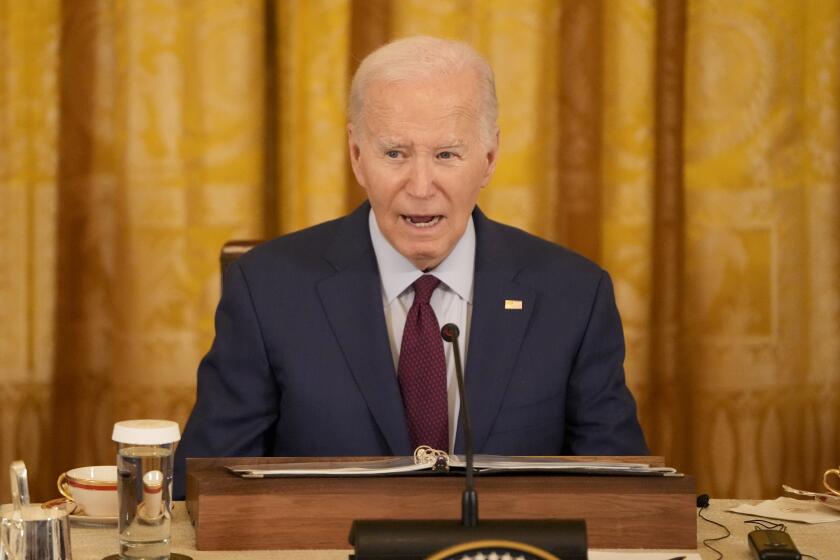Schools Vary Sex Education Approach : Some Aim for Frankness While Others Try to Avoid Controversies
Everybody’s got it, almost everybody experiences it, but there’s not much agreement in San Diego County on how to teach it to our children.
Sex.
How do public schools teach a subject that is steeped in personal, parental and religious values, but which most people believe, according to public opinion polls, should be taught in the classroom?
When it comes to math, there’s little discrepancy among school districts about what skills to teach at what levels. Simple addition of whole numbers comes in first and second grade; mixed fractions come around fourth grade; algebra is introduced in eighth grade, and 10th graders can figure on getting hit with geometry.
But there is virtually no consensus in San Diego County in how to teach sex education.
Teachers in San Dieguito and Oceanside have been teaching contraception to seventh graders without parental objection for more than five years, but when the Vista Unified School District said a couple of weeks ago it wanted to do the same, 1,000 parents signed petitions objecting. And if seventh-graders in Fallbrook raise the seemingly non-controversial issue of abstinence as a form of birth control, they’re told that it’s not a matter of classroom discussion and to talk to their parents about it. Fallbrook allows no discussion of any form of contraception.
The ninth-grade curriculum in Oceanside calls for discussions on homosexuality and masturbation, and spirited debates on abortion are conducted in classrooms, featuring representatives from anti-abortion and pro-choice groups. In Escondido, however, 10th-grade teachers are encouraged to steer away from such controversial subjects. “Our district has traditionally relied on parental training” when it comes to discussing the pros and cons of such issues, a school official said.
Indeed, a spectrum of approaches to sex or family life education is represented in San Diego County; issues that are controversial in one district are sleepers in others, and even schools in the same community reflect different philosophies on how to approach the subject of sex and sexuality.
Although the Fallbrook elementary school district is admittedly conservative in its teaching of sex education, its students graduate into the separately governed Fallbrook High School district where contraceptives, abortion and homosexuality are a prescribed part of the curriculum. “There’s nothing that we don’t cover,” Fallbrook High School Principal Hank Woessner said unabashedly.
Perhaps the most free-wheeling sex education program in the county is offered by the San Diego Unified School District--which in 1938 was the first school district in the United States to offer sex education, although probably under a different name.
In the San Diego city schools, 16 specially trained men and women visit each school’s eighth- and 10th-graders one hour a day for a week, with a simple mission: to answer each and every question about sex and sexuality that is asked.
There are no textbooks and no course outlines, but the students have enough questions to keep the teachers busy every minute of that annual five-day program.
San Diego city schools, as do most schools in the county, show films to fifth-grade girls on menstruation and feminine hygiene. Sixth-grade boys and girls learn about animal and human reproductive systems and sexually transmitted diseases. They also begin discussions on “critical decision making” and how people have to take responsibility for their actions by accepting the consequences.
But the real substance of the district’s sex education program is in eighth and 10th grades, when the question-and-answer sessions are conducted.
Boys and girls meet separately in the eighth-grade session, which is conducted in the context of a mandatory health class (although the state allows parents to pull their children out of class when sex is discussed). The questions are asked anonymously via a “question box,” and all questions are answered as long as they do not invade someone’s privacy, said Nancy Siemers, coordinator of the district’s “Social Concerns” program, which includes both sex and substance-abuse education.
Typical eighth-grade questions, she said, include “What does a boy want when he goes on a date?” “How do you get pregnant?” “How do you know you’re pregnant?” and “How do you keep from getting pregnant?”
It’s not unusual, also, for the students to ask about incest, molestation, masturbation, homosexuality and artificial insemination.
They also seek details on contraceptives and how abortions are performed. “It’s not necessarily because they’re sexually active, but because they’ve heard so much about them already,” she said.
The 10th-grade sex education session is contained within a health and safety course which is not required for graduation and therefore is attended by only about half of the district’s students.
As in the eighth grade, the sophomore class is essentially a question-and-answer session, although the questions are more sophisticated and tend to focus more on personal rights, dealing with peer pressure and rape.
Siemers calls the district’s program “pathetic and laughable” because of its brevity, especially given the irony that the district was the first in the nation to begin sex education classes.
“The kids get five hours a year in each of eighth and 10th grade, and that’s supposed to counteract the thousands of hours they’re exposed to heavy rock, television and everything else these kids hear and see every day?” she asked.
“But what the program at least does is tell these kids that if they want to talk to someone in greater depth, we’re here for them,” she added. “We don’t give grades or tests or send referrals to the office. And nobody in their right mind is late for a class on sex. We’re the good guys on campus. We don’t create hassles for the kids; we help them deal with the hassles.”
The San Marcos Unified School District is re-writing its sex education curriculum, prompted by the revelation that during the 1983-84 school year, 20% of the high school girls admitted to a school counselor that they were pregnant.
Currently, seventh-grade students are given some science instruction on human anatomy, the reproductive system and sexually transmitted diseases, but little more.
Ninth-graders are required to take a course in “critical decision making,” which relates to such topics as self-esteem, study habits and how to enhance critical thinking skills--such as when to have, or not to have, sex or take drugs.
Most ninth-graders in San Marcos also attend a biology class in which about three weeks is spent on the physiology of sex and the human reproductive system, while seniors have the option of taking a course called “Living in Style,” which includes discussion on teen-age sexuality.
Now, a committee of parents, teachers, clergy and others is debating whether contraceptives should be taught in seventh or eighth grade.
“I recognized we didn’t have much of a sex education program, but I questioned the cost-effectiveness of it, especially in light of other deficiencies in the more traditional roles of the school,” said Supt. William Streshly. “You have to weigh how much focus you put on sex education, compared to math, science, reading, social studies and all the rest.”
Streshly said his district, in line with the philosophy laid down by Bill Honig, the state superintendent of schools, has stressed the 3 Rs, perhaps at the expense of sex education.
“But these days, with the decline of the family, the church, legal order and justice, schools are more pressured to step in, and now we find ourselves in the position of having to teach ethics.”
Streshly said he still is not interested in promoting improved sex education per se, because he is not sure how effective it would be. “We have mandatory physical education, and if it were successful, we’d be a nation of warriors. But we’re not.”
The focus in San Marcos, instead, will be to develop an attitude of success and positive self-esteem among the district’s students, the superintendent said.
San Marcos Junior High School Principal Joe DeDiminicantanio elaborated:
“The problem is more complex than teen-age girls becoming pregnant. It relates to a student’s ability to make proper decisions. We want to attack that problem, which will not only help them in matters of sex, but with drugs and alcohol as well.”
In fact, many school districts around San Diego County already offer instruction in “critical decision making,” and most districts specifically couple it with issues of drug abuse and premarital sex.
Among those school districts where contraceptives are a formal and specific part of the school curriculum in seventh or eighth grade are El Cajon Valley, Oceanside, Vista, San Dieguito and, most recently, in Vista. The Poway school district quietly introduced contraception into the sixth-grade sex education program several years ago, without any public flap.
Besides San Marcos, districts where contraception is not specifically discussed in junior high schools include Carlsbad, Escondido, Fallbrook, La Mesa-Spring Valley, Sweetwater and San Diego Unified.
But in those districts, questions about contraceptives generally are raised anyway, and it is up to the individual teacher to what degree the question is answered, officials around the county say.
“We don’t deny that contraceptives are available, but we refer our eighth-graders to their home or church,” said Dr. James M. Doyle, assistant superintendent for instruction in the Sweetwater Union High School District.
Wilhelmine Nielsen, assistant superintendent of Escondido’s elementary schools, said, “Contraceptives are discussed in response to children’s questions. We’ll give an honest--and brief--answer.”
Yvonne Johnson, assistant superintendent in the Cajon Valley Union (Elementary) School District, said a family-life curriculum begins in kindergarten (“life produces life”), continues through the primary grades (the family structure), and by the sixth grade students are talking about interpersonal relationships, sex drives and human reproduction.
But because of concern that school districts should not interject values, abstinence is mentioned but not promoted as a form of birth control. “I wouldn’t touch that (abstinence being the best birth control method) with a 10-foot pole,” Johnson said, laughing. “That’s a value judgment I don’t want to impose. I can give the facts, but I can’t say this or that is the best.”
On the other hand, Fallbrook High’s teachers specifically try “to influence (students) on the side of abstinence,” said Principal Hank Woessner.
And without apparent regard to the feelings of those adults who might endorse intercourse outside of marriage, the La Mesa-Spring Valley School District tells its seventh graders that intercourse “is the privilege of married people in our society, and the ultimate expression of mature love.”
The San Dieguito High School District has struck a sort of middle ground. Class discussions are held in 10th grade on such issues as birth control, abortion, masturbation and homosexuality, “but we always tell the student that the information he has from his home or religious background should be the basis on which he makes his own decisions on the issues.”
Students air the issue of abortion by researching both sides to the controversy and then, in debate format, represent first one side, and then the other, she said.
Peggy Slocum, curriculum director in Vista, said her district’s seventh-grade teachers wanted the formal blessing of school board members to discuss contraceptive not only because the question was being raised anyway by students, but because “kids talk about it outside of school, and there’s an awful lot of misinformation being spread about.”
“Even if most children don’t use or need contraceptives, it’s important they understand how to use them so they themselves become a pool of knowledge when some of these tales start spreading. The result is, for those kids who don’t listen to their teacher, they’ll at least assimilate the correct information from their peers.”
Beginning next year, Vista’s seventh-grade boys will learn about sexual desires, sexually transmitted diseases, “antisocial behaviors,” pregnancy and family planning while taking a shop class.
The seventh-grade girls will learn the same things while taking a class that also includes how to prepare pancakes and peanut butter cookies and how to make an apron, tote bag or patchwork pillow.
How effective are any of the county’s approaches to sex education?
Said San Diego Unified School District’s Siemers:
“I can’t prove that I kept Suzy Q. from getting pregnant or getting VD, but if I keep two girls from getting pregnant in a year, I’ve paid for the district’s entire sex education program.”
More to Read
Start your day right
Sign up for Essential California for news, features and recommendations from the L.A. Times and beyond in your inbox six days a week.
You may occasionally receive promotional content from the Los Angeles Times.






